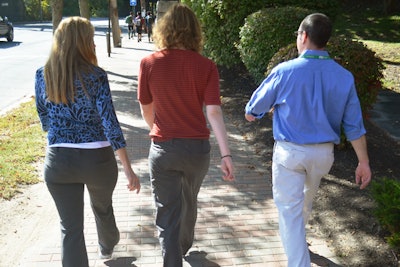
The next time you have to organize a meeting or conference, take note: The most beneficial strategy may be to have participants walk as they talk. A recent study conducted by the University of Miami Miller School of Medicine found that a walking meeting can boost participants’ health, mood, and productivity.
Jeff Hurt, executive vice president for education and engagement at Velvet Chainsaw Consulting, says this latest study reinforces what brain researchers have been declaring for some time: Our bodies are made to move. “Learning is not equivalent to the amount of time your butt sits in a chair and listens," he says. "It’s actually directly correlated to how much thinking you do. And the more you can move your body during the thinking process, the higher the retention and recall process is of your learning. The longer you sit, the less you retain, the less you recall, the less you’re listening.”
In the study, 18 office workers who conducted weekly meetings in groups of two or three were invited to wear accelerometers to measure physical activity levels over three consecutive weeks. The results showed that turning just one seated meeting per week into a walking meeting increased workplace physical activity levels by 10 minutes. Researchers wrote that the study shows walking meetings are “easy to implement and feasible to conduct during regular working hours” and are “needed to counter the negative health effects of sedentary behavior.”
Hurt says many schools and universities have been implementing “active learning” strategies for some time, and that means millennials have an expectation that when they attend meetings and conferences, they will do more than just sit in a chair all day. “What we tell people to do for a conference is [that] instead of focusing on the content or the speaker, you need to focus on what the audience is going to do during the session or during that keynote or during that presentation. And if it’s just ‘sit and git,’ as they say here in Texas, it’s not worth it,” Hurt says.
Suggestions for walking meetings from the study and from Let’s Go, a childhood obesity prevention program, include:
1. Set a time and place to meet.
2. Distribute an agenda to participants.
3. Encourage participants to bring comfortable clothing, walking shoes, water, and sunglasses and sunscreen if going outside.
4. Select a route with wide walkways.
5. Assign roles. For example, one person keeps an eye on time, another takes notes, and another sets the walk route.
6. Ask walkers to turn off their cell phones.
7. Walk at a pace that is comfortable for all, for a minimum of 30 minutes.
8. After the meeting, recap and document next steps.
If walking is not feasible for an entire meeting or session, other ideas include “walk and talk” breaks (participants are given a topic to discuss as they walk and then reconvene to share ideas), creating stations that attendees rotate through, or conducting a meeting while standing. “There’s a lot of research that says a 10-minute standing meeting has more impact than a 30-minute sitting meeting," says Hurt. "When the body is standing erect the spinal cord is straight, the lungs can get more oxygen, and more oxygen can get to the brain.”



















